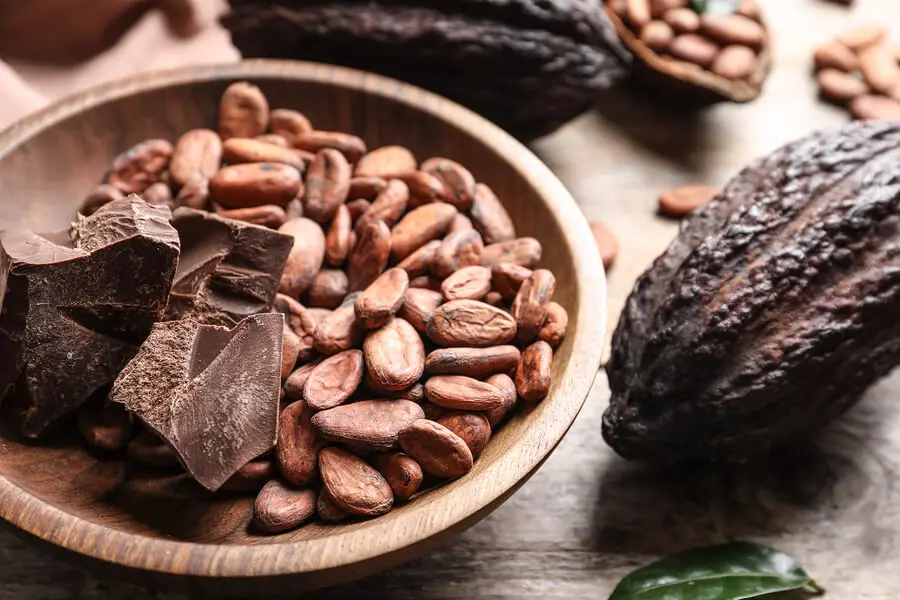Is Cocoa Butter Good for Lip Care?

Cocoa butter bars stand out among the best natural alternatives to moisturize lips. The product is frequently used for lip moisturizing, especially when extreme temperature changes crack this delicate skin.
Constant exposure to environmental factors, the continuous use of mouthguards or orthodontics, and daily mechanical functions (talking, eating, yawning) all increase the risk of suffering cracks, dryness, and allergies.
In fact, a publication of the Spanish Academy of Dermatology and Venereology notes that the lips are a very sensitive area, especially if they suffer from some basic alteration, such as cheilitis. That’s when the possibility of solving dry lips with cocoa arises.
Cocoa butter as a cosmetic
For cosmetic transformation, the butter is extracted from the beans pressed up to 550 kg/cm² and filtered to eliminate solid remains, according to the European Cocoa Association (ECA). The institution adds that cocoa is a key ingredient in the production of chocolate and in the manufacture of cosmetics and toiletries.
Thanks to its properties, coco butter acts as an insulator and protector. The formula includes vitamins A, C and E, which are known for their antioxidant powers and for helping to delay the signs of aging.
Cocoa-based balms are also known as cocoa lip balms, julri oil or theobroma. Aside from lip balms, you get them in soaps, lotions and creams.
We think you may also enjoy reading this article: 10 Beauty Treatments that Can Regenerate Skin Collagen
The advantages of cocoa butter for lips
Using coco oil to moisturize isn’t a new trend. Thanks to its moisturizing properties, cocoa beans have been used as a natural remedy since ancient times, and its use has been oriented to skin care.
In the same vein, there’s research concerning the therapeutic effects of the butter on skin disorders. In addition, those who use it claim the following benefits for the lips.

Coco butter is antioxidant
Coco butter bars contain polyphenolics and flavonoids, which are known for their venotonic, antioxidant and regenerating actions.
It’s hydrating
As an emollient, this butter protects the lips from the weather, such as sun damage, the cold in winter, and indoor heat. The product is a powerful moisturizer that works from the inside out, absorbing the fat in cocoa to heal dryness and cracks.
It strengthens collagen production
When you use cocoa lip balm daily, you promote elastin and collagen production and can avoid the need for aggressive cosmetic procedures to enhance the appearance of your mouth.
It soothes mouth sores
Irritation and sores on the lips cause pain. In addition to the painkillers often prescribed by doctors, spreading a little butter offers a soothing and softening sensation.
Coco butter bastes good
The new lip cocoa formulas offer a silkier and more pleasant texture as a result of the fusion with other ingredients, such as nourishing vegetable oils, essential oils, aromatic herbs, and spices. The goal is to achieve refreshing notes and a good taste.
Like this article? You may also like to read: How to Clean the Beauty Blender or Blurring Sponge Without Damaging It
What are the risks of using cocoa butter for lips?
Aside from the benefits of coco oil, it’s necessary to be aware of the formula, as not all of them are equally beneficial. The skin of the lips is extremely thin, and when exposed to the weather without protection, it may crack and bleed.
There’s no problem if you moisturize with the butter from cocoa beans, as long as it’s prepared with the correct substances.
Suitable ingredients in a cocoa lip balm
Certain ingredients are counterproductive because they tend to irritate the mucous membrane. On the other hand, it’s essential that the following ingredients appear in the recipe:
- Vitamin E: You can call it tocopherol acetate or just tocopherol. This substance is the strongest antioxidant in lip cocoa.
- Waxes: They may be natural or chemical, but the important thing is that they’re there. Some options are white beeswax, carnauba wax, or candelilla wax.
- Butters: Shea butter is a great ally for the positive effects of cocoa.
- Oils: Almond oil and castor oil stand out among the oil alternatives for a great cocoa lip balm.
- Sunscreens: Finally, it’s important to include protection against UV rays. To do this, check that the product contains titanium or zinc oxide.
If you have any questions as to the concentrations or permitted substances, check the list called the International Nomenclature of Cosmetic Ingredients(INCI Beauty).

Compromising formulas
On the other hand, it’s important to avoid cocoa butter lip balms made with more water than active ingredients, as they tend to carry higher amounts of preservatives, such as parabens and phenoxyethanol.
In terms of antioxidants, butylated hydroxytoluene (BHT) and beta hydroxy acid (BHA) aren’t suitable, as they could cause allergies, as well as chemical filters, such as benzophenone-3.
Make sure to slect lip balms without dyes, with little perfume, and that don’t contain any allergens.
Recommendations for better lip balm effects
The best cocoa butter lip balms are those recommended by dermatologists. Since prevention is important, don’t lend the stick to anyone else; make sure it’s for your exclusive use. And if your lips are excessively chapped or you suffer from herpes, it’s best to suspend use until you get some medical advice.
Another tip is to buy the butter for direct application and not for spreading with your fingers, because it’s easily contaminated. Finally, pay attention to the expiration date so as not to swipe an expired substance in your mouth.
All cited sources were thoroughly reviewed by our team to ensure their quality, reliability, currency, and validity. The bibliography of this article was considered reliable and of academic or scientific accuracy.
- Álvarez-Parrilla E, De la Rosa Carrillo L, López Díaz JA, Mercado-Mercado G, Wall-Medrano A. Compuestos polifenólicos y capacidad antioxidante de especias típicas consumidas en México. Nutrición Hospitalaria. Vol. 28. Núm. 1. España; 2013. https://scielo.isciii.es/scielo.php?script=sci_arttext&pid=S0212-16112013000100005
- Campos Bedoya P, Magaña Serrano JA, San Esteban Sosa JE, Waizel Haiat S, Waizel Bucay J. Cacao y Chocolate: seducción y terapéutica. Análes Médicos. Vol. 57. Núme. 3. pp. 236-245. México; 2012. https://www.medigraphic.com/pdfs/abc/bc-2012/bc123k.pdf
- El proceso de producción – desde granos de cacao hasta productos semielaborados. Asociación Europea del Cacao. Luxemburgo. https://www.eurococoa.com/es/historia-del-cacao-el-cacao-como-materia-prima/cocoa-story-el-proceso-de-produccion-desde-granos-de-cacao-hasta-productos-semielaborados/#:~:text=La%20manteca%20se%20extrae%20de,s%C3%B3lida%20en%20cajas%20de%20cart%C3%B3n.
- Ingredientes utilizados en cosmética. INCI beauty. https://incibeauty.com/es/ingredients
- López Luengo MT. Flavonoides. Offarm. Vol. 21. Núm. 4. España; 2002. https://www.elsevier.es/es-revista-offarm-4-articulo-flavonoides-13028951
- Merino N. La piel y el frío: diez consejos. Academia Española de Dermatología y Venereología. España; 2015. https://aedv.es/comunicacion/notas-de-prensa/la-piel-y-el-frio-diez-consejos/
This text is provided for informational purposes only and does not replace consultation with a professional. If in doubt, consult your specialist.








